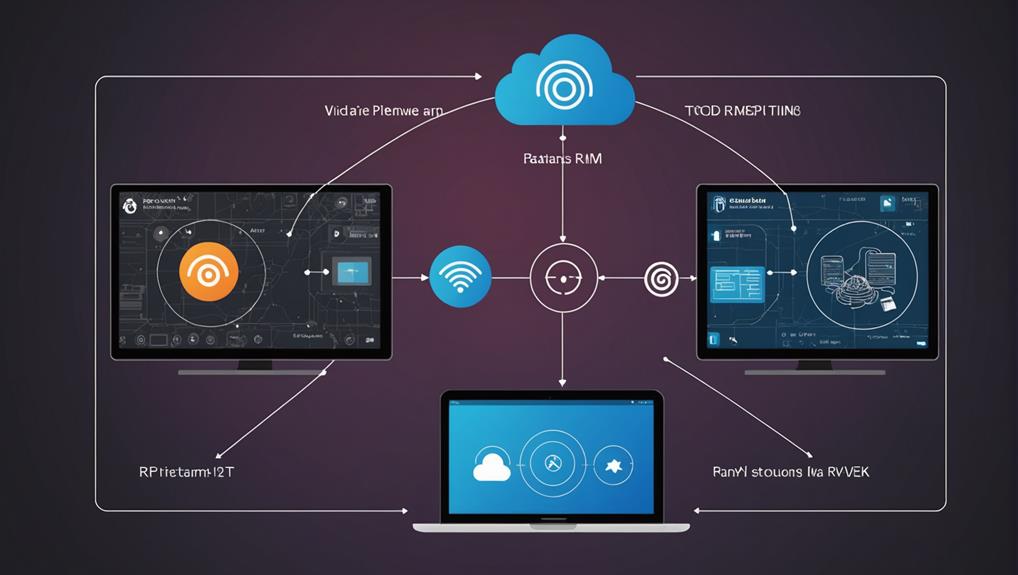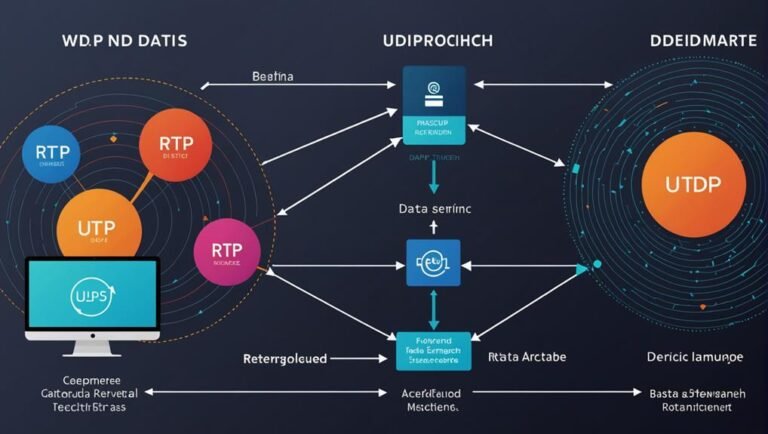When choosing between RTSP and RTMP, you’ll notice clear differences. RTSP, or Real-Time Streaming Protocol, is designed for real-time applications like video conferencing and surveillance, yet it may require more bandwidth and comes with some delays. On the other hand, RTMP, developed by Adobe, is perfect for live broadcasting, offering low latency and higher quality, making it ideal for content creators. RTMP maintains a constant connection, ensuring smooth playback, while RTSP allows bi-directional communication. Understanding these contrasts will help you select the right protocol for your needs, and there’s more to discover about their specific use cases.
Overview of RTSP
When you’re streaming media, it is vital to understand the protocols involved, and RTSP (Real-Time Streaming Protocol) is one of the primary options. RTSP allows you to control playback of media streams, offering you the freedom to play, pause, and seek as you wish. One of the RTSP advantages is its ability to handle real-time data, making it ideal for applications like video conferencing or live broadcasts. You can enjoy a seamless experience while watching or participating in events.
However, it is important to recognize RTSP limitations, too. For instance, it may require more bandwidth compared to other protocols, which can affect your streaming quality if your connection isn’t robust enough. Additionally, RTSP often relies on other protocols for actual media delivery, so you might need to take into account additional setup.
RTSP applications are diverse, ranging from IP surveillance cameras to interactive media systems. If you’re setting up a surveillance system, RTSP can enable you to access camera feeds over the internet, providing both real-time monitoring and playback functionality.
Overview of RTMP
RTMP, or Real-Time Messaging Protocol, is a powerful option for streaming media, particularly for live broadcasts. If you’re looking for a method that offers low latency and high-quality video, RTMP streaming is worth considering. Developed by Adobe, this protocol has been a staple in the streaming world, allowing you to deliver audio, video, and data over the internet in real-time.
What makes the RTMP protocol stand out is its ability to maintain a constant connection between the server and the client. This means you can achieve smooth playback, making it ideal for live events such as sports, concerts, or any situation where timing is essential. You don’t want to miss a moment due to lag, right? With RTMP streaming, you can engage your audience more effectively, providing them with a seamless experience.
Another advantage of RTMP is its compatibility with various encoding software and streaming platforms. It’s pretty flexible, allowing you to use different tools to capture and broadcast your content. Plus, RTMP supports adaptive bitrate streaming, which means viewers can enjoy the best quality their internet connection allows.
In a world where freedom of expression and creativity is key, RTMP gives you the tools you need to reach your audience effectively. So, whether you’re a content creator, educator, or entertainer, understanding and utilizing the RTMP protocol can be a game changer for your streaming endeavors. Embrace the possibilities that come with it!
Key Differences
Understanding the key differences between RTMP and RTSP can greatly impact your streaming choices. Both are popular streaming protocols, but they cater to different needs and scenarios in video delivery. Here are some critical distinctions to evaluate:
- Latency: RTMP typically offers lower latency, making it ideal for live streaming. RTSP, however, may introduce slight delays.
- Compatibility: RTMP is widely supported by various platforms and devices, while RTSP’s compatibility is more limited, often found in specific applications.
- Streaming Direction: RTMP is designed primarily for server-to-client communication, whereas RTSP allows for bi-directional communication, enabling more interactive experiences.
- Use Cases: RTMP is often used for live broadcasts and real-time streaming. In contrast, RTSP is more common in surveillance and on-demand streaming applications.
When you’re deciding which protocol to use, think about your specific needs. If you’re looking for a solution that minimizes latency and supports broad compatibility, RTMP might be your best bet. On the other hand, if you need interactive features or are focused on surveillance, RTSP could be the right choice.
Ultimately, understanding these key differences in streaming protocols will empower you to make informed decisions that align with your unique video delivery requirements. Embrace your freedom to choose the right protocol, and take your streaming experience to the next level!
Use Cases for RTSP
While RTMP excels in live streaming scenarios, RTSP shines in specific applications that require more interactivity and control. If you’re looking to implement video streaming in environments where user engagement is essential, RTSP might just be what you need. It’s particularly effective in surveillance systems, where you want to monitor feeds in real-time without excessive delays. The ability to control playback—like pausing, rewinding, or fast-forwarding—gives you a level of interactivity that’s hard to beat.
Another great use case for RTSP is in video conferencing solutions. Here, low network latency is significant. You want seamless communication, and RTSP helps guarantee that your video streams stay synchronized, allowing for natural conversations without awkward pauses. This makes it a go-to choice for businesses that rely on real-time interactions.
IP cameras also leverage RTSP for delivering live video feeds. This application is essential in security and monitoring setups, where you can access multiple camera streams without fuss. The protocol’s ability to handle a variety of streaming formats means you won’t be limited in how you deliver content.
In educational settings, RTSP can be used for interactive learning experiences, allowing students to engage with video content dynamically. Whether you’re monitoring your home, conducting business meetings, or teaching online, RTSP offers flexibility and control, making it an excellent choice for applications that demand more than just passive viewing.
Use Cases for RTMP
When it comes to live streaming, RTMP is often the go-to choice for those looking to deliver high-quality content with minimal latency. This protocol shines in various use cases, empowering creators and businesses to connect with their audiences seamlessly. Whether you’re a gamer, a content creator, or a corporate entity, RTMP can elevate your streaming experience.
Here are some key use cases for RTMP:
- Gaming Streams: If you’re streaming your gameplay on platforms like Twitch, RTMP guarantees your audience experiences your content in real-time with low latency.
- Webinars and Online Events: RTMP’s reliability makes it perfect for hosting live webinars, allowing you to engage with participants through Q&A sessions instantly.
- Live Sports Broadcasting: For those in the sports industry, RTMP enables you to broadcast live events without delay, providing viewers with the excitement they crave.
- Social Media Live Streams: Many social media platforms support RTMP, letting you share your live moments directly with your followers, creating a more interactive experience.
Using RTMP not only enhances the quality of your live streaming but also gives you the freedom to connect with your audience in real-time. It’s about making your content as engaging as possible while minimizing any lag or interruptions. With its low latency capabilities, RTMP truly stands out as a versatile choice for anyone serious about live streaming.
Frequently Asked Questions
What Platforms Support RTSP and RTMP Streaming Protocols?
When you’re exploring streaming compatibility, you’ll find that many platforms support both RTSP and RTMP protocols. Popular choices like VLC, Wowza, and OBS allow you to leverage their protocol advantages for seamless streaming. If you want flexibility in live broadcasting or on-demand content, these protocols can cater to your needs. So, whether you’re streaming to a personal project or a larger audience, you’ve got options that empower your creative freedom.
How Can I Troubleshoot RTSP and RTMP Connection Issues?
Imagine you’re a sailor charting turbulent seas. To troubleshoot connection issues, you’ll need to check your compass and sails—your connection diagnostics and network configurations. Start by ensuring your network’s stable, like a calm harbor. Check firewalls and port settings, as they can be like stormy waves blocking your path. If things still feel off, consider using tools like ping and traceroute to pinpoint the trouble, steering your ship back on course to smooth streaming.
Are RTSP and RTMP Secure for Streaming Sensitive Content?
When you’re streaming sensitive content, it’s essential to take into account security. Both RTSP and RTMP have protocol vulnerabilities that could expose your data. While they can be used with streaming encryption, it’s not always implemented by default. If you want to guarantee your content stays private, you should look into additional security measures and possibly opt for protocols designed with safety in mind. Don’t compromise your freedom; safeguard your streams effectively.
Can I Convert RTSP Streams to RTMP Format Easily?
Did you know that nearly 80% of online viewers prefer seamless streaming experiences? If you’re looking to convert RTSP streams to RTMP format, you’ll find it’s quite straightforward. Many tools and software exist to facilitate this streaming conversion, ensuring protocol compatibility. With just a few clicks, you can enjoy the freedom to broadcast your content across various platforms. Embrace this opportunity to reach wider audiences without hassle!
What Are the Bandwidth Requirements for RTSP and Rtmp?
When considering bandwidth requirements, you’ll find that RTSP typically demands less than RTMP, especially for live streaming. This bandwidth comparison can greatly affect your streaming efficiency. If you’re aiming for seamless viewing experiences, it’s essential to evaluate your network conditions and the quality you expect. Ultimately, choosing the right protocol can give you the freedom to enjoy uninterrupted content while managing your bandwidth effectively.



